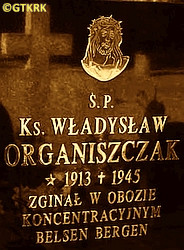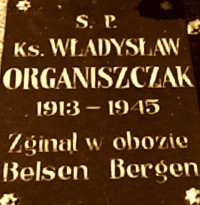Roman Catholic
St Sigismund parish
05-507 Słomczyn
85 Wiślana Str.
Konstancin deanery
Warsaw archdiocese, Poland
full list:
displayClick to display full list

searchClick to search full list by categories
wyświetlKliknij by wyświetlić pełną listę po polsku

szukajKliknij by przeszukać listę wg kategorii po polsku

Martyrology of the clergy — Poland
XX century (1914 – 1989)
personal data

surname
ORGANISZCZAK
surname
versions/aliases
ORGANIŚCIAK
forename(s)
Vladislav (pl. Władysław)
function
religious cleric
creed
Latin (Roman Catholic) Church RCmore on
en.wikipedia.org
[access: 2014.09.21]
congregation
Congregation of the Holy Family Missionaries MSFmore on
fr.wikipedia.org
[access: 2014.09.21]
(i.e. Missionaries of the Holy Family)
date and place
of death
20.04.1945

KL Bergen‐Belsenconcentration camp
today: n. Bergen, Celle dist., Lower Saxony state, Germany
more on
en.wikipedia.org
[access: 2022.01.09]
alt. dates and places
of death
24.06.1945
details of death
Right before German and Russian invasion of Poland in 09.1939 and start of the World War II returned to Poland to celebrate his first Holy Mass.
Forced to stay in German occupied Poland. Ministered in Warsaw.
After the fall of the Warsaw Uprising on 02.10.1944 in an internment camp, prob. DL 121 Pruszków.
From there prob. deported to the KL Groß–Rosen concentration camp.
In the face of the Russian Vistula‐Oder offensive, which in 01.1945 reached the Oder line and led to the siege by Russian troops of Wrocław, announced by the Germans as Germ. Festung Breslau (Eng. Wrocław Fortress), and then the following Russian offensive known as the Lower Silesian Operation that begun on 08.02.1945, prob. driven in the‐so–called „death marches” from KL Groß–Rosen to the west (the camp itself was liberated by the Russians on 14.02.1945).
Reached KL Mittelbau‐Dora concentration camp where slaved in underground munitions factories (registered as electrician on 11.02.1945).
Next on c. 15.03.1945 moved prob. in one of „death marches” to KL Bergen‐Belsen concentration camp where perished soon after liberation of the camp on 15.04.1945 by British troops — without recovering.
prisoner camp's numbers
115739Click to display source page (KL Mittelbau‐DoraClick to display the description)
cause of death
extermination
perpetrators
Germans
sites and events
KL Bergen‐BelsenClick to display the description, KL Mittelbau‐DoraClick to display the description, KL Groß‐RosenClick to display the description, DL 121 PruszkówClick to display the description, Warsaw UprisingClick to display the description, GeneralgouvernementClick to display the description, Ribbentrop‐MolotovClick to display the description, Pius XI's encyclicalsClick to display the description
date and place
of birth
24.09.1913Birth certification on:
photos.szukajwarchiwach.gov.pl
[access: 2025.04.13]

Stankowotoday: Stankowo gm., Gostyń pov., Greater Poland voiv., Poland
more on
en.wikipedia.org
[access: 2021.12.18]
parents
ORGANIŚCIAK John
🞲 ?, ? — 🕆 ?, ?

MOCHALSKA Mary
🞲 ?, ? — 🕆 ?, ?
religious vows
15.08.1934 (temporary)
presbyter (holy orders)
ordination
05.08.1939

Ravengiersburgtoday: Rhein‐Hunsrück dist., Rhineland‐Palatinate state, Germany
more on
en.wikipedia.org
[access: 2022.08.05]
positions held
till 1939
student — Ravengiersburgtoday: Rhein‐Hunsrück dist., Rhineland‐Palatinate state, Germany
more on
en.wikipedia.org
[access: 2022.08.05] ⋄ Theological Study (higher theological seminary), Congregation's house, Missionaries of the Holy Family MSF
c. 1933 – 1934
novitiate — Missionaries of the Holy Family MSF
others related
in death
FLORKOClick to display biography Joseph, GRZĄDKAClick to display biography Hippolytus, MACIERZYŃSKIClick to display biography Paul Augustine, MAKIELAClick to display biography Theodore Francis, SZWAJNOCHClick to display biography Steven
sites and events
descriptions
KL Bergen‐Belsen: Till 1944 KL Bergen‐Belsen was a prisoner‐of‐war camp, in 1944 was changed into the German Germ. Konzentrationslager (Eng. concentration camp) KL, in 1945 in so‐called „death marches” thousands of prisoners from other concentration camps were transferred, approx. 50,000 of them died in Bergen‐Belsen. When the camp on 15.04.1945 was liberated by the British troops c. 13,000 unburied bodies were found together with c. 60,000 inmates, emaciated, starving, without a food or drink for days, suffering from illness and sickness, mainly typhoid. C. 14,000 of them perished in next two months without regaining strength and health. (more on: pl.wikipedia.orgClick to attempt to display webpage
[access: 2012.11.23], en.wikipedia.orgClick to attempt to display webpage
[access: 2014.03.10])
KL Mittelbau‐Dora: German Germ. Konzentrationslager (Eng. concentration camp) KL, operational from 08.1943 till 11.04.1945 when American troops entered the camp. Set up to provide the slave workforce for an underground military factory „Mittelwerk” — in tunnels of Kohnstein mountain n. Nordhausen town V‐1 and V‐2 rockets were manufactured. Initially functioned as a sub‐camp of KL Buchenwald concentration camp (till summer 1944). Approx. 20,000 prisoner perished (large part of them were brought there at the end of 1944, in „death marches”, from KL Auschwitz), among whom 10,000 during camp evacuation (which also took form of „death marches”) — in 04.1945, right before liberation. Also c. 1,200 prisoners perished during bombardments by the Allied forces. (more on: en.wikipedia.orgClick to attempt to display webpage
[access: 2022.01.09])
KL Groß‐Rosen: Groß‐Rosen (today: Rogoźnica) was a German Germ. Konzentrationslager (Eng. concentration camp) KL, founded in the summer of 1940 (first transport of prisoners arrived on 02.08.1940). Initially a branch of KL Sachsenhausen concentration camp. In 1944 became a centre of a network of more than 100 camps. Prisoners were forced to slave at nearby granite quarries, on starvation rations. More than 125,000 prisoners were enslaved — 40,000 victims perished. In 1945 — in „death marches” — Germans dragged through the camp thousands of prisoners from the camp’s in east being one by one overrun by the Russians. The camp itself was captured by the Russians on 14.02.1945. (more on: www.gross-rosen.euClick to attempt to display webpage
[access: 2021.07.18], en.wikipedia.orgClick to attempt to display webpage
[access: 2019.02.02])
DL 121 Pruszków: Germ. Durchgangslager 121 Pruszków (Eng. Transit Camp) — transit camp where Germans herded Warsaw (and its vicinity) civilian population captured during and after Warsaw Uprising. Set up on 06.01.1944 functioned till 12.1944. C. 390,000‐410,000 people were held captive. Most of them were sent subsequently to concentration camps and forced slave labour in Germany. Few hundred ‐ few thousands of them perished in the camp. (more on: pl.wikipedia.orgClick to attempt to display webpage
[access: 2015.03.01])
Warsaw Uprising: Lasted from 01.08.1944 till 03.10.1944. Was an attempt to liberate Polish capital from occupying Germans by the Polish Clandestine State — a unique in the history of the world political structure on the territories occupied by the Germans, effectively governing clandestinely in Poland — and by fighting on its behalf underground military units, mainly of Home Army (former Armed Struggle Association ZWZ) and National Armed Forced (NSZ). At the same time Russians stopped on purpose the offensive on all front, halted on the other bank of Vistula river and watched calmly the annihilation of the city, refusing even the mid‐landing rights to the Allied planes carrying weapons and supplies to the insurgents from Italy. During the Uprising Germans murdered approx. 200,000 Poles, mainly civilians. Approx. 200 priests and nuns died in fighting or were murdered by the Germans, many in mass executions. (more on: en.wikipedia.orgClick to attempt to display webpage
[access: 2013.08.17])
Generalgouvernement: After the Polish defeat in the 09.1939 campaign, which was the result of the Ribbentrop‐Molotov Pact and constituted the first stage of World War II, and the beginning of German occupation in part of Poland (in the other, eastern part of Poland, the Russian occupation began), the Germans divided the occupied Polish territory into five main regions. In two of them new German provinces were created, two other were incorporated into other provinces. However, the fifth part was treated separately, and in a political sense it was supposed to recreate the German idea from 1915 (during World War I, after the defeat of the Russians in the Battle of Gorlice in 05.1915) of creating a Polish enclave within Germany. Illegal in the sense of international law, i.e. Hague Convention, and public law, managed by the Germans according to separate laws — especially established for the Polish Germ. Untermenschen (Eng. subhumans) — till the Russian offensive in 1945 it constituted part of the Germ. Großdeutschland (Eng. Greater Germany). Till 31.07.1940 formally called Germ. Generalgouvernement für die besetzten polnischen Gebiete (Eng. General Government for the occupied Polish lands) — later simply Germ. Generalgouvernement (Eng. General Governorate), as in the years 1915‐1918. From 07.1941, i.e. after the German attack on 22.06.1941 against the erstwhile ally, the Russians, it also included the Galicia district, i.e. the Polish pre‐war south‐eastern voivodeships. A special criminal law was enacted and applied to Poles and Jews, allowing for the arbitrary administration of the death penalty regardless of the age of the „perpetrator”, and sanctioning the use of collective responsibility. After the end of the military conflict of the World War UU, the government of the Germ. Generalgouvernement was recognized as a criminal organization, and its leader, governor Hans Frank, guilty of war crimes and crimes against humanity and executed. (more on: en.wikipedia.orgClick to attempt to display webpage
[access: 2024.12.13])
Ribbentrop‐Molotov: Genocidal Russian‐German alliance pact between Russian leader Joseph Stalin and German leader Adolf Hitler signed on 23.08.1939 in Moscow by respective foreign ministers, Mr. Vyacheslav Molotov for Russia and Joachim von Ribbentrop for Germany. The pact sanctioned and was the direct cause of joint Russian and German invasion of Poland and the outbreak of the World War II in 09.1939. In a political sense, the pact was an attempt to restore the status quo ante before 1914, with one exception, namely the „commercial” exchange of the so‐called „Kingdom of Poland”, which in 1914 was part of the Russian Empire, fore Eastern Galicia (today's western Ukraine), in 1914 belonging to the Austro‐Hungarian Empire. Galicia, including Lviv, was to be taken over by the Russians, the „Kingdom of Poland” — under the name of the General Governorate — Germany. The resultant „war was one of the greatest calamities and dramas of humanity in history, for two atheistic and anti‐Christian ideologies — national and international socialism — rejected God and His fifth Decalogue commandment: Thou shall not kill!” (Abp Stanislav Gądecki, 01.09.2019). The decisions taken — backed up by the betrayal of the formal allies of Poland, France and Germany, which on 12.09.1939, at a joint conference in Abbeville, decided not to provide aid to attacked Poland and not to take military action against Germany (a clear breach of treaty obligations with Poland) — were on 28.09.1939 slightly altered and made more precise when a treaty on „German‐Russian boundaries and friendship” was agreed by the same murderous signatories. One of its findings was establishment of spheres of influence in Central and Eastern Europe and in consequence IV partition of Poland. In one of its secret annexes agreed, that: „the Signatories will not tolerate on its respective territories any Polish propaganda that affects the territory of the other Side. On their respective territories they will suppress all such propaganda and inform each other of the measures taken to accomplish it”. The agreements resulted in a series of meeting between two genocidal organization representing both sides — German Gestapo and Russian NKVD when coordination of efforts to exterminate Polish intelligentsia and Polish leading classes (in Germany called «Intelligenzaktion», in Russia took the form of Katyń massacres) where discussed. Resulted in deaths of hundreds of thousands of Polish intelligentsia, including thousands of priests presented here, and tens of millions of ordinary people,. The results of this Russian‐German pact lasted till 1989 and are still in evidence even today. (more on: en.wikipedia.orgClick to attempt to display webpage
[access: 2015.09.30])
Pius XI's encyclicals: Facing the creation of two totalitarian systems in Europe, which seemed to compete with each other, though there were more similarities than contradictions between them, Pope Pius XI issued in 03.1937 (within 5 days) two encyclicals. In the „Mit brennender Sorge” (Eng. „With Burning Concern”) published on 14.03.1938, condemned the national socialism prevailing in Germany. The Pope wrote: „Whoever, following the old Germanic‐pre‐Christian beliefs, puts various impersonal fate in the place of a personal God, denies the wisdom of God and Providence […], whoever exalts earthly values: race or nation, or state, or state system, representatives of state power or other fundamental values of human society, […] and makes them the highest standard of all values, including religious ones, and idolizes them, this one […] is far from true faith in God and from a worldview corresponding to such faith”. On 19.03.1937, published „Divini Redemptoris” (Eng. „Divine Redeemer”), in which criticized Russian communism, dialectical materialism and the class struggle theory. The Pope wrote: „Communism deprives man of freedom, and therefore the spiritual basis of all life norms. It deprives the human person of all his dignity and any moral support with which he could resist the onslaught of blind passions […] This is the new gospel that Bolshevik and godless communism preaches as a message of salvation and redemption of humanity”… Pius XI demanded that the established human law be subjected to the natural law of God , recommended the implementation of the ideal of a Christian state and society, and called on Catholics to resist. Two years later, National Socialist Germany and Communist Russia came together and started World War II. (more on: www.vatican.vaClick to attempt to display webpage
[access: 2023.05.28], www.vatican.vaClick to attempt to display webpage
[access: 2023.05.28])
sources
personal:
www.msf.opoka.org.plClick to attempt to display webpage
[access: 2012.12.28], photos.szukajwarchiwach.gov.plClick to attempt to display webpage
[access: 2025.04.13]
bibliographical:
„International Tracing Service (ITS), Bad Arolsen, GermanyClick to display source page”, Arolsen Archives
original images:
billiongraves.comClick to attempt to display webpage
[access: 2017.11.07], billiongraves.comClick to attempt to display webpage
[access: 2017.11.07]
LETTER to CUSTODIAN/ADMINISTRATOR
If you have an Email client on your communicator/computer — such as Mozilla Thunderbird, Windows Mail or Microsoft Outlook, described at WikipediaPatrz:
en.wikipedia.org, among others — try the link below, please:
LETTER to CUSTODIAN/ADMINISTRATORClick and try to call your own Email client
If however you do not run such a client or the above link is not active please send an email to the Custodian/Administrator using your account — in your customary email/correspondence engine — at the following address:

giving the following as the subject:
MARTYROLOGY: ORGANISZCZAK Vladislav
To return to the biography press below:
 Click to return to biography
Click to return to biography









